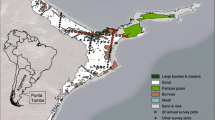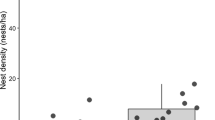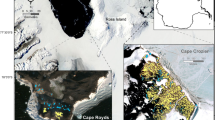Abstract
Introduced mammals have been eradicated from many offshore islands around the world, removing predation pressure from burrow-nesting seabirds and other affected wildlife. Nest-site selection in procellariiform seabirds is mediated by nesting habitat characteristics and social information, although it is unclear if, or how, nest-site selection will affect post-eradication colony growth. Using a Bayesian hierarchical modeling approach we assessed how nest-site selection differs among burrow-nesting seabird colonies at different stages of recovery after Pacific rat (Rattus exulans) eradication. We compared nest-site selection in a community of seven procellariiform species among six offshore islands in northeastern New Zealand: four designated rat-free over a continuum within the last 26 years, an island which never had rats, and an island with rats present. We hypothesized that, immediately after eradication, birds would be constrained to nesting habitat where they were less vulnerable to predation, and as time since eradication increased birds would eventually spread to new habitat. We found a positive relationship between mean burrow density and time since rat eradication. Soil depth was the most important predictor of burrow presence, abundance, and occupancy in plots among islands, with more burrows found in deeper soil. We found that the relationships between habitat covariates and nest-site selection decreased with increasing time since eradication. The probability of a covariate having a significant effect on nest-site selection decreased with increasing time since eradication and decreasing variability in the covariate across an island. Our results suggest that the eradication of rodents reduced constraints on petrel nesting distribution and that nest-site selection in burrow-nesting petrels may be influenced by burrow density, where selection of particular nesting habitat characteristics may be relatively more important in small recovering populations. We conclude that colony expansion immediately after predator removal is complex, influenced by numerous interacting factors, but may be partly limited by the availability of suitable nesting habitat.






Similar content being viewed by others
References
Anderson DP et al (2013) Predicting Microstegium vimineum invasion in natural plant communities of the southern Blue Ridge Mountains, USA. Biol Invasions 15:1217–1230
Atkinson IAE (1985) The spread of commensal species of Rattus to oceanic islands and their effects on island avifauna. In: Moors PJ (ed) Conservation of island birds. ICBP, Cambridge, pp 35–81
Atkinson IAE (2004) Successional processes induced by fires on the northern offshore islands of New Zealand. N Z J Ecol 28:181–193
Bancroft WJ, Roberts JD, Garkaklis MJ (2005a) Burrow entrance attrition rate in wedge-tailed shearwater Puffinus pacificus colonies on Rottnest Island, Western Australia. Mar Ornithol 33:23–26
Bancroft WJ, Garkaklis MJ, Dale Roberts J (2005b) Burrow building in seabird colonies: a soil-forming process in island ecosystems. Pedobiologia 49:149–165
Banerjee S, Carlin BP, Gelfand AE (2004) Hierarchical modeling and analysis for spatial data. Chapman and Hall/CRC Monographs on Statistics and Applied Probability, Boca Raton
Bates D, Maechler M, Bolker B (2012) lme4: linear mixed-effects models using S4 classes. R package version 1.1-6. http://CRAN.R-project.org/package=lme4.CRAN
Bayard TS, Elphick CS (2010) Using spatial point-pattern assessment to understand the social and environmental mechanisms that drive avian habitat selection. Auk 127:485–494
Bergin DO, Kimberley MO, Marden M (1995) Protective value of regenerating tea tree stands on erosion-prone hill country, East Coast, North Island, New Zealand. N Z J For Sci 25:3–19
Bivand R et al (2013) spdep: spatial dependence: weighting schemes, statistics and models. R package version 0.5-56. http://CRAN.R-project.org/package=spdep
Bourgeois K, Vidal É (2007) Yelkouan shearwater nest-cavity selection and breeding success. C R Biol 330:205–214
Brandt CA, Parrish JK, Hodges CN (1995) Predictive approaches to habitat quantification: dark-rumped petrels on Haleakala, Maui. Auk 112:571–579
Burger AE, Gochfeld M (1991) Nest-site selection by the Herald Petrel and White-tailed Tropicbird on Round Island, Indian Ocean. Wilson Bull 103:126–130
Burger J, Gochfeld M (1994) Predation and effects of humans on island-nesting seabirds. In: Nettleship DN, Burger J, Gochfeld M (eds) Seabirds on islands, threats, case studies and action plans. Birdlife International, Cambridge, pp 39–67
Buxton RT (2014) Ecological drivers of seabird recovery after the eradication of introduced predators, PhD Thesis, University of Otago, Dunedin, New Zealand
Buxton RT et al (2013a) Examining patterns in nocturnal seabird activity and recovery across the western Aleutian Islands, Alaska, using automated acoustic recording. Auk 130:331–341
Buxton RT et al (2013b) Incidence of plastic fragments among burrow-nesting seabird colonies on offshore islands in northern New Zealand. Mar Pollut Bull 74:420–424
Buxton RT et al (2014) Drivers of seabird population recovery on New Zealand islands after predator eradication. Conserv Biol 28:333–344
Campbell DJ, Atkinson IAE (1999) Effects of kiore (Rattus exulans Peale) on recruitment of indigenous coastal trees on northern offshore islands of New Zealand. J R Soc N Z 29:265–290
Catry P et al (2003) Population census and nesting habitat selection of thin-billed prion Pachyptila belcheri on New Island, Falkland Islands. Polar Biol 26:202–207
Catry P et al (2007) Can thin-billed prions Pachyptila belcheri breed successfully on an island with introduced rats, mice and cats? The case of New Island, Falkland Islands. Polar Biol 30:391–394
Charleton K et al (2009) Spatial variation in burrow entrance density of the sooty shearwater (Puffinus griseus). Notornis 56:1–10
Clout M, Russell JC (2006) The eradication of introduced mammals from New Zealand islands. In: Koike F, Clout M, Kawamichi M, De Poorter M, Iwatsuki K (eds) Assessment and control of biological invasion risks. IUCN and Shoukadoh Book Sellers, Gland, Switzerland and Kyoto, Japan, pp 127–141
Cody ML (1985) Habitat selection in birds. Academic Press, Orlando
Craig JL (1983) The effect of kiore on other fauna. In: Wright AE, Beever RE (eds) The offshore islands of northern New Zealand. Department of Lands and Survey Information Series, Wellington, pp 75–83
Cressie N et al (2009) Accounting for uncertainty in ecological analysis: the strengths and limitations of hierarchical statistical modeling. Ecol Appl 19:553–570
Cuthbert R (2002) The role of introduced mammals and inverse density-dependent predation in the conservation of Hutton’s shearwater. Biol Conserv 108:69–78
Dagne GA (2004) Hierarchical Bayesian analysis of correlated zero-inflated count data. Biom J 46:653–663
Dalsted KJ et al (1981) Application of remote sensing to prairie dog management. J Range Manag 34:218–223
Danchin E, Boulinier T, Massot M (1998) Conspecific reproductive success and breeding habitat selection: implications for the study of coloniality. Ecology 79:2415–2428
Dawson J, Lucas R (2011) New Zealand’s native trees. Craig Potton Publishing, Nelson
Doligez B et al (2003) When to use public information for breeding habitat selection? The role of environmental predictability and density dependence. Anim Behav 66:973–988
Drummond BA, Leonard M (2010) Reproductive consequences of nest site use in Fork-tailed Storm-Petrels in the Aleutian Islands, Alaska: potential lasting effects of an introduced predator. Avian Conserv Ecol 5:4
Edgar AT (1962) A visit to the mercury Islands. Notornis 10:1–15
Ellison AM (1996) An introduction to Bayesian inference for ecological research and environmental decision-making. Ecol Appl 6:1036–1046
Forbes LS, Kaiser GW (1994) Habitat choice in breeding seabirds: when to cross the information barrier. Oikos 70:377–384
Freeman E, Moison G (2008) Presence absence: an R Package for presence–absence model analysis. J Stat Softw 23:1–31. http://www.jstatsoft.org/v23/i11
Fretwell SD (1972) Populations in a seasonal environment. Princeton University Press, Princeton
Fretwell S, Lucas H Jr (1969) On territorial behavior and other factors influencing habitat distribution in birds. Acta Biotheor 19:16–36
Gaze P (2000) The response of a colony of sooty shearwater (Puffinus griseus) and flesh-footed shearwater (P carneipes) to the cessation of harvesting and the eradication of Norway rats (Rattus norvegicus). N Z J Zool 27:279–375
Gelman A, Hill J (2007) Data analysis using regression and multilevel/hierarchical models. Cambridge University Press, New York
Gelman A et al (2004) Bayesian data analysis. Chapman and Hall/CRC Press, Boca Raton
Genz A et al (2012) Mvtnorm: multivariate normal and t distributions. R package version 0.9-9994. http://CRAN.R-project.org/package=mvtnorm
Ginzburg L, Jensen C (2004) Rules of thumb for judging ecological theories. Trends Ecol Evol 19:121–126
Grant-Hoffman M, Mulder C, Bellingham P (2009) Invasive rats alter woody seedling composition on seabird-dominated islands in New Zealand. Oecologia 163:449–460
Hamilton S (2000) How precise and accurate are data obtained using an infra-red scope on burrow-nesting Sooty Shearwaters Puffinus griseus. Mar Ornithol 28:1–6
Hardy MA (1993) Regression with dummy variables. Quantitative applications in the social sciences. Sage, Newbury Park, California
Hicks GRF et al (1975) An ecological reconnaissance of Korapuki Island, Mercury Islands. Notornis 22:195–220
Hill MO (1979) TWINSPAN: a FORTRAN program for arranging multivariate data in an ordered two-way table by classification of the individuals and attributes. Cornell University, Ithaca
Holdaway RN, Worthy TH, Tennyson A (2001) A working list of breeding bird species of the New Zealand region at first human contact. N Z J Ecol 28:119–187
Jones C (2000) Sooty shearwater (Puffinus griseus) breeding colonies on mainland South Island, New Zealand: evidence of decline and predictors of persistence. N Z J Zool 27:327–334
Jones J (2001) Habitat selection studies in avian ecology: a critical review. Auk 118:557–562
Jones C (2003) Safety in numbers for secondary prey populations: an experimental test using egg predation by small mammals in New Zealand. Oikos 102:57–66
Jones HP (2010) Prognosis for ecosystem recovery following rodent eradication and seabird restoration in an island archipelago. Ecol Appl 20:1204–1216
Jones HP et al (2008) Severity of the effects of invasive rats on seabirds: a global review. Conserv Biol 22:16–26
Jones HP et al (2011) Recovery and restoration on seabird islands. In: Mulder C, Anderson W, Towns DR, Bellingham P (eds) Seabird islands: ecology, invasion and restoration. Oxford University Press, New York
Kesler DC, Haig SM (2005) Selection of arboreal termitaria for nesting by cooperatively breeding Micronesian Kingfishers Todiramphus cinnamominus reichenbachii. Ibis 147:188–196
Kildaw SD et al (2005) Formation and growth of new seabird colonies: the significance of habitat quality. Mar Ornithol 33:49–58
Kohn DD, Walsh DM (1994) Plant species richness: the effect of island size and habitat diversity. J Ecol 82:367–377
Legendre P (1993) Spatial autocorrelation: trouble or new paradigm? Ecology 74:1659–1673
Lyver POB, Robertson CJR, Moller H (2000) Predation at sooty shearwater (Puffinus griseus) colonies on the New Zealand mainland: is there safety in numbers? Pac Conserv Biol 5:347–357
Major HL, Lemon MJF, Hipfner JM (2011) Habitat as a potential factor limiting the recovery of a population of nocturnal seabirds. J Wildl Manag 76:793–799
Martin TG et al (2005) Zero tolerance ecology: improving ecological inference by modelling the source of zero observations. Ecol Lett 8:1235–1246
Miskelly CM (2013) New Zealand Birds Online. http://www.nzbirdsonline.org.nz/. September 2014
Moller H, Craig JL (1987) The population ecology of Rattus exulans on Tiritiri Matangi Island, and a model of comparative population dynamics in New Zealand. N Z J Zool 14:305–328
Mulder CPH et al (2011) Impact of seabirds on plant and soil properties. In: Mulder CPH, Anderson W, Towns DR, Bellingham P (eds) Seabird islands: ecology, invasion and restoration. Oxford University Press, New York
Newman DG, McFadden I (1990) Seasonal fluctuations of numbers, breeding, and food of kiore (Rattus exulans) on Lady Alice Island (Hen and Chickens group), with a consideration of kiore: tuatara (Sphenodon punctatus) relationships in New Zealand. N Z J Zool 17:55–63
Oppel S et al (2012) Comparison of five modelling techniques to predict the spatial distribution and abundance of seabirds. Biol Conserv 156:94–104
Oro D (2008) Living in a ghetto within a local population: an empirical example of an ideal despotic distribution. Ecology 89:838–846
Oro D et al (2006) Influence of density dependence on predator-prey seabird interactions at large spatio-temporal scales. Proc R Soc B Biol Sci 273:379–383
Pierce RJ (2002) Kiore (Rattus exulans) impact on breeding success of Pycroft’s petrels and little shearwaters. DOC Science Internal Series, DOC, Wellington
Priddel D et al (2006) Decline in the distribution and abundance of Flesh-footed Shearwaters (Puffinus carneipes) on Lord Howe Island, Australia. Biol Conserv 128:412–424
R Development Core Team (2012) R: a language and environment for statistical computing. R Foundation for Statistical Computing, Vienna, Austria. ISBN 3-900051-07-0. http://www.R-project.org/
Rauzon MJ (2007) Island restoration: exploring the past, anticipating the future. Mar Ornithol 35:97–107
Rayner MJ, Hauber ME, Clout M (2007a) Breeding habitat of the Cook’s Petrel (Pterodroma cookii) on Little Barrier Island (Hauturu): implications for the conservation of a New Zealand endemic. Emu 107:59–68
Rayner MJ et al (2007b) Spatial heterogeneity of mesopredator release within an oceanic island system. Proc Natl Acad Sci 104:20862–20865
Regehr H et al (2007) Recovery of the Ancient Murrelet Synthliboramphus antiquus colony on Langara Island, British Columbia, following eradication of invasive rats. Mar Ornithol 35:137–144
Ribeiro PJ, Diggle PJ (2001) GeoR: a package for geostatistical analysis. R-NEWS 1:15–18
Rodway MS, Chardine JW, Montevecchi WA (1998) Intra-colony variation in breeding performance of Atlantic Puffins. Colon Waterbirds 21:171–184
Rosenzweig ML (1981) Theory of habitat selection. Ecology 62:327–335
Schielzeth H (2010) Simple means to improve the interpretability of regression coefficients. Methods Ecol Evol 1:103–113
Schramm M (1986) Burrow densities and nest site preferences of petrels (Procellaridae) at the Prince Edward Islands. Polar Biol 6:63–70
Schulz M, Robinson S, Gales R (2005) Breeding of the Grey Petrel (Procellaria cinerea) on Macquarie Island: population size and nesting habitat. Emu 105:323–329
Scott D et al (2009) Predictive habitat modelling to estimate petrel breeding colony sizes: sooty shearwaters (Puffinus griseus) and mottled petrels (Pterodroma inexpectata) on Whenua Hou Island. N Z J Zool 36:206–291
Sladden B, Falla RA (1928) Alderman Islands. N Z J Sci Technol 9:282–290
Smith JL, Mulder CPH and Ellis JC (2011) Seabirds as ecosystem engineers: nutrient inputs and physical disturbance. In: Mulder WA CPH, Towns DR, Bellingham P (eds) Seabird islands: ecology, invasion and restoration. Oxford University Press, New York
Spiegelhalter DJ et al (2002) Bayesian measures of model complexity and fit. J R Stat Soc Ser B (Stat Method) 64:583–639
Springer AM (1991) Seabird relationships to food webs and the environment; examples from the North Pacific Ocean. Canadian Wildlife Service, Ottawa
Stenhouse IJ, Montevecchi WA (2000) Habitat utilization and breeding success in Leach’s Storm-petrel: the importance of sociality. Can J Zool 78:1267–1274
Stokes DL, Boersma PD (1991) Effects of substrate on the distribution of Magellanic penguin (Spheniscus magellanicus) burrows. Auk 108:923–933
Taylor GA (2000) Action plan for seabird conservation in New Zealand, Part A. Threatened species occasional publication. Department of Conservation, Wellington, NZ
Thompson KR, Furness RW (1991) The influence of rainfall and nest-site quality on the population dynamics of the Manx shearwater Puffinus puffinus on Rhum. J Zool 225:427–437
Towns DR (2009) Eradications as reverse invasions: lessons from Pacific rat (Rattus exulans) removals on New Zealand islands. Biol Invasions 11:1719–1733
Towns DR (2011) Eradication of vertebrate pests from islands around New Zealand: what have we delivered and what have we learned? In: Veitch CR, Clout M, Towns DR (eds) Island invasives: eradication and management. IUCN, Gland, Switzerland, pp 364–371
Towns DR, Atkinson IAE, Daugherty CH (2006) Have the harmful effects of introduced rats on islands been exaggerated? Biol. Invasions 8:863–891
Towns DR et al (2011) Impacts of introduced predators on seabirds. In: Mulder C, Anderson W, Towns DR, Bellingham P (eds) Seabird islands: ecology, invasion and restoration. Oxford University Press, New York, pp 56–90
Veitch CR et al (2011) Changes in bird numbers on Raoul Island, Kermadec Islands, New Zealand, following the eradication of goats, rats, and cats. In: Veitch CR, Clout M, Towns DR (eds) Island invasives: eradication and management. IUCN, Gland, Switzerland, pp 372–376
Venables WN, Ripley B (2002) Modern applied statistics with S, 4th edn. Springer, New York
Wagner HH, Fortin M-J (2005) Spatial analysis of landscapes: concepts and statistics. Ecology 86:1975–1987
Warham J (1990) The petrels: their ecology and breeding systems. Academic Press, San Diego, CA
Welsh AH et al (1996) Modelling the abundance of rare species: statistical models for counts with extra zeros. Ecol Model 88:297–308
Westgate MJ, Likens GE, Lindenmayer DB (2013) Adaptive management of biological systems: a review. Biol Conserv 158:128–139
Wheeler DC, Hickson DA, Waller LA (2010) Assessing local model adequacy in Bayesian hierarchical models using the partitioned deviance information criterion. Comput Stat Data Anal 54:1657–1671
Whitehead A et al (2014) Establishing accurate baseline estimates of breeding populations of a burrowing seabird, the grey-faced petrel (Pterodroma macroptera gouldi) in New Zealand. Biol Conserv 169:106–116
Wittenberger JF, Hunt GL (1985) The adaptive significance of coloniality in birds. In: Farner DS, King JR, Parkes KC (eds) Avian biology. Academic Press, New York, pp 1–78
Acknowledgments
Approval to access our study islands was granted by Ngātiwai Trust Board, Ruamaahua Islands Trust, Ngāti Hei Trust, Ngāti Whanaunga, the Hauraki Collective and the regional Department of Conservation of Northland and Hauraki. Special thanks to C. Currey, F. Vonken, S. Reid, D. Hamon, K. Hawkins, C. Stone, C. Farr, B. Karl, M. Coleman and R. Chappell for field assistance. Statistical support was provided by A. Whitehead. This project was funded by the New Zealand Ministry for Business, Innovation and Employment through the Te Hiringa Tangata Ki Tai Pari Ki Tai Timu study (contract C09X0908), the University of Otago, and the National Sciences and Engineering Research Council of Canada (NSERC).
Author information
Authors and Affiliations
Corresponding author
Electronic supplementary material
Below is the link to the electronic supplementary material.
Rights and permissions
About this article
Cite this article
Buxton, R.T., Anderson, D., Moller, H. et al. Release of constraints on nest-site selection in burrow-nesting petrels following invasive rat eradication. Biol Invasions 17, 1453–1470 (2015). https://doi.org/10.1007/s10530-014-0807-x
Received:
Accepted:
Published:
Issue Date:
DOI: https://doi.org/10.1007/s10530-014-0807-x




